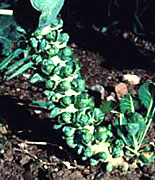


Home
Flowers &
Indoor Plants
Fruits & Nuts
Ornamentals
Vegetables
Special Topics
Resources
Glossary

Brussels Sprouts (Gemmifera Group) |
 |
What about it? Only one in ten gardeners in this country grow Brussels sprouts, (and those of us who do are passionate about them!) The harvest of Brussels sprouts can extend well into the winter months, making this a rare, fresh home-grown vegetable for northern growers to enjoy during the cold months. What is it used for? The "sprouts" appear along the stem, looking like small cabbages. Sprouts of the best quality are compact with no splitting. Where does it grow? How do we grow it?Brussels sprouts thrive in cool weather. For a good fall crop, the sprouts' maturity needs to coincide with the first few frosty days of the year. If you plant them too early, their flavor may be too strong; too late and heavy frost followed by thaw can make them rot. Brussels sprouts should be fertilized and mulched regularly. Brussels sprouts should be started out in flats. In these flats seeds should be sown 1 inch apart. Transplant the sprouts into 2 1/2-inch pots after the first two true leaves appear. When roots are established, transplant to the garden, spacing the plants 14 to 24 inches apart. To sow seeds d i rectly in the garden, plant 4 to 5 seeds per foot to a depth of 1/4 inch. What are its primary problems? Watch out for cabbage root maggots, aphids, flea beetles, imported cabbageworms, and cabbage loopers. Possible diseases include black rot, dubroot, downy mildew, and white mold. How do we harvest and store it? The best harvest is after a touch of frost. Harvest sprouts from the bottom of the plant up when they are 1 to 1 1/2 inches in diameter. Harvest Brussels sprouts as needed. The plants can tolerate a light frost. Brussels sprouts can be snapped off the plant or neatly cut with a sharp knife. Remove sprouts with a bit of stalk attached, which can be neatly trimmed later. Brussels sprouts will keep several weeks in the refrigerator. They need high humidity, so store them in a perforated plastic bag to maintain moisture.
© Copyright, Department of Horticulture, Cornell University. |



